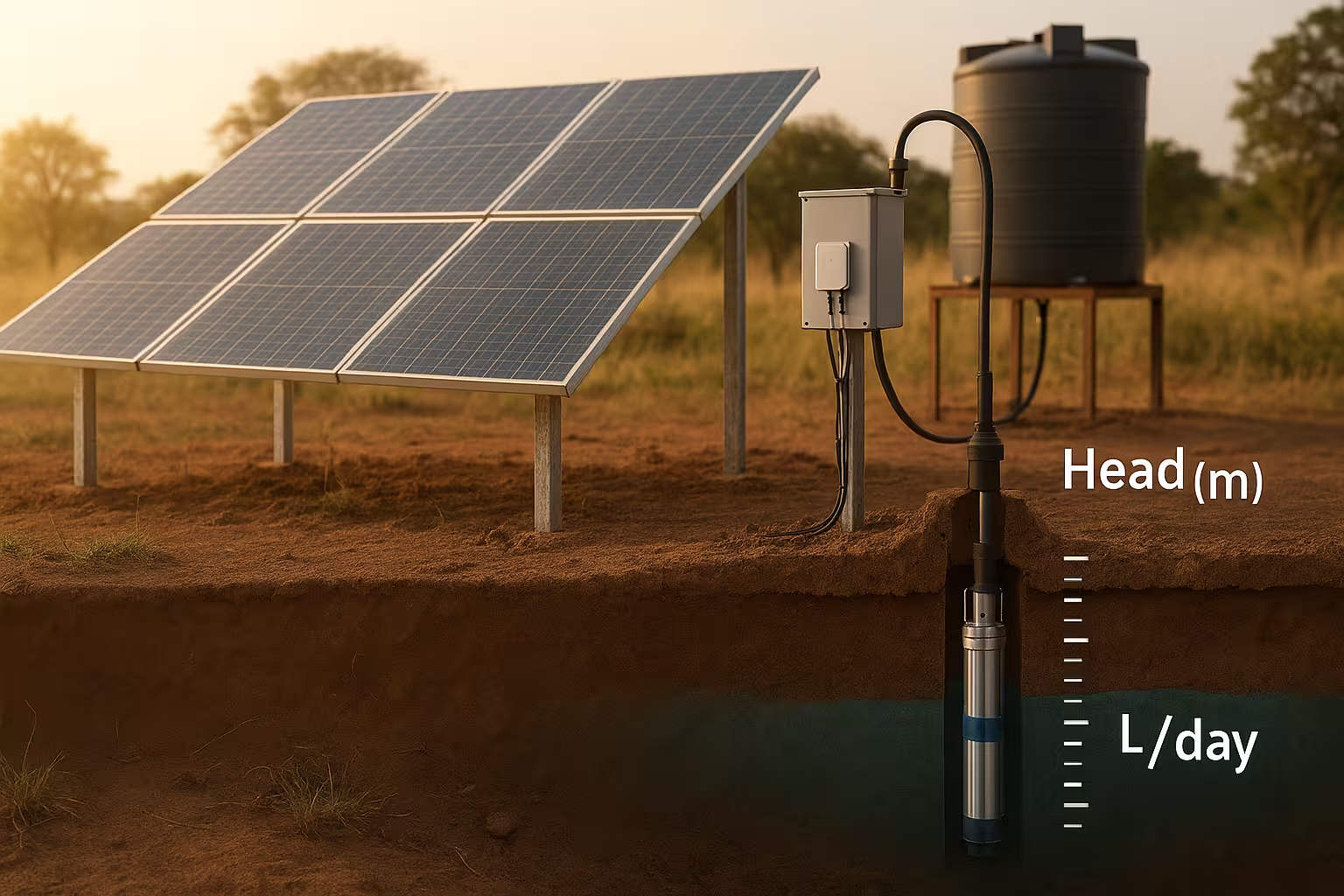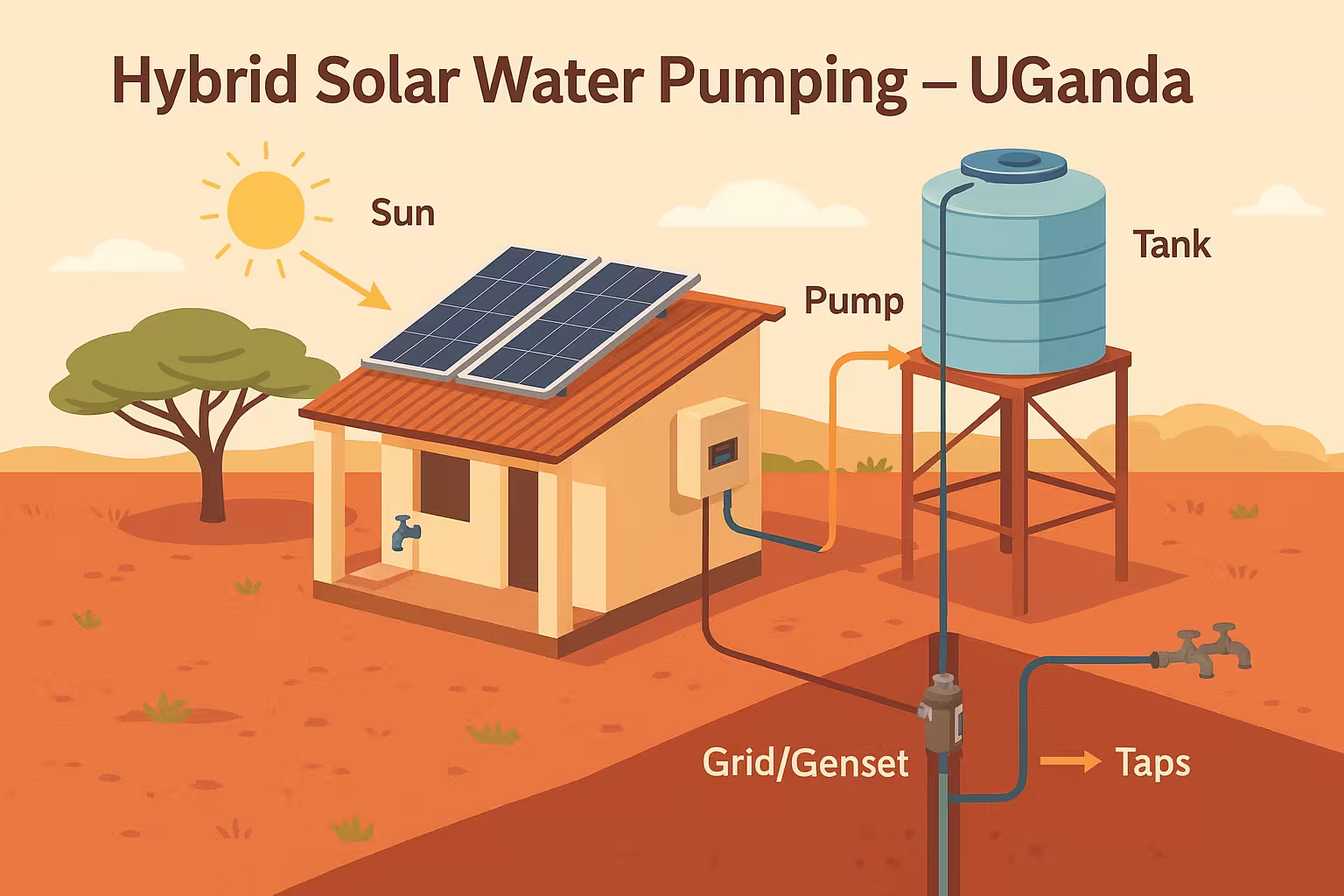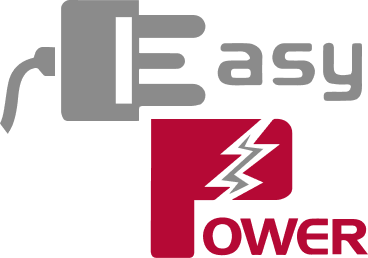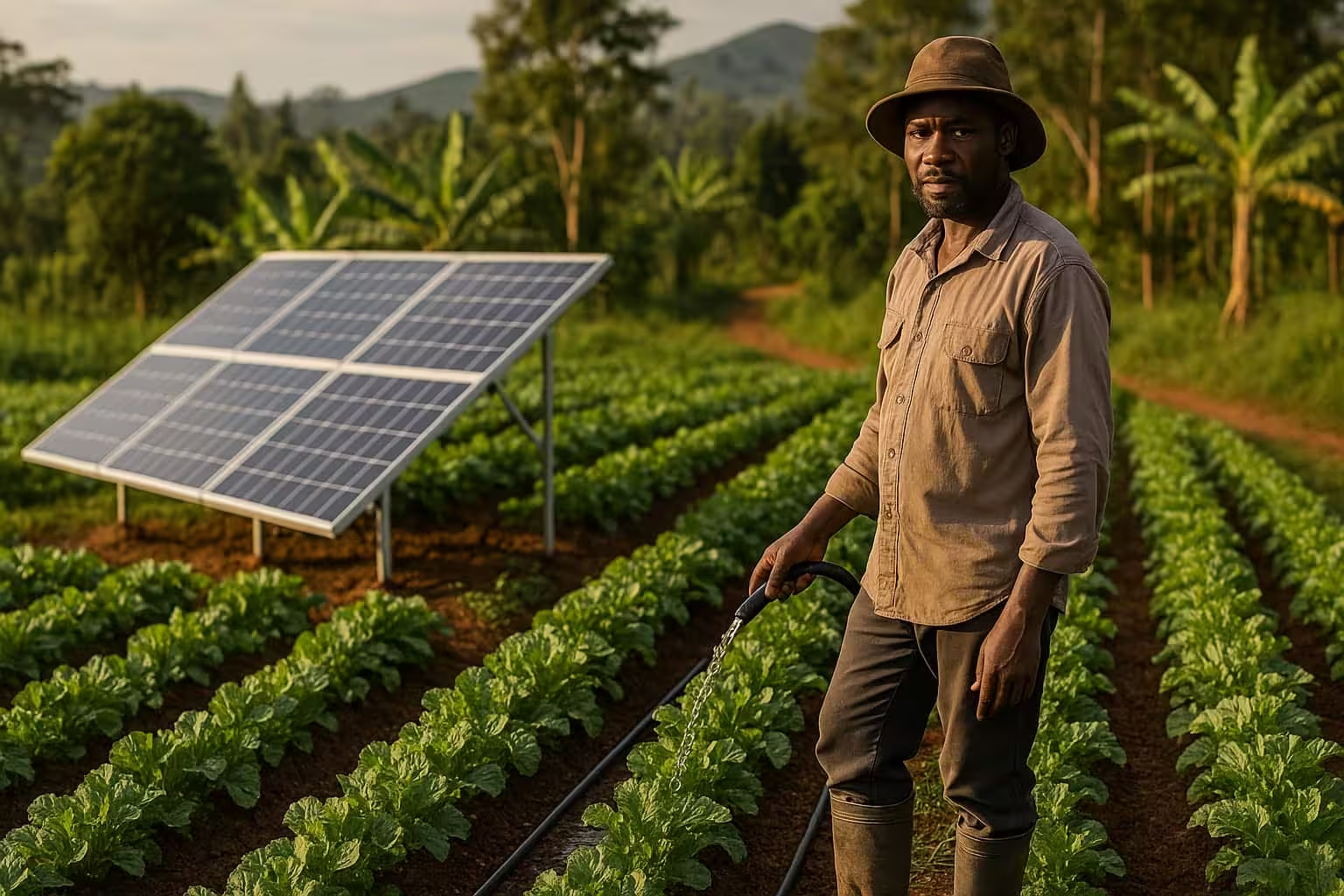Solar water pumps in Uganda come in a few clear types.
Pick the right one for your head, litres per day, and source.
Here’s the simple, field‑tested guide.
DC submersible solar borehole pumps in Uganda
Best for deep boreholes and long pipe runs.
Brushless DC motors run straight from panels via a controller.
High efficiency. Low maintenance.
Use cases: community boreholes, small estates, clinic supply.
Typical head & flow: 30–80 m; 6 000–30 000 L/day.
Array hint: pump power (W) × 1.3 for Uganda’s 5–6 peak‑sun‑hours.
Design note: add a non‑return valve and sand screen.
👉 Deep dive: Submersible solar water pumps in Uganda
AC submersible deep‑well solar pumps in Uganda (with inverter)

Use when you need an AC borehole pump or already have a hybrid inverter.
A VFD/MPPT drives the AC motor from solar and smooths starts.
Good for retrofits.
Use cases: deep wells, high heads, legacy AC installs.
Typical head & flow: 40–120 m; 8 000–50 000 L/day.
Array hint: size for peak draw; check VFD surge.
Design note: allow for cable losses on long drops.
Surface solar transfer pumps in Uganda (rivers, tanks, shallow wells)
Place the pump beside the water source and push uphill.
Avoid long suction—keep lifts under 7–8 m.
Simple, serviceable, and affordable.
Use cases: tank‑to‑tank transfer, ponds, shallow wells.
Typical head & flow: 5–25 m; 2 000–10 000 L/day.
Array hint: smaller arrays; morning priming helps.
Design note: foot valve + strainer protect the impeller.
👉 Related read: Solar surface water pumps in Uganda
Solar booster pumps for raised water tanks in Uganda
Pressurize taps from a storage tank.
Keeps pressure steady for homes, schools and clinics.
Runs quietly.
Use cases: rooftop/stand tank to bathrooms and kitchens.
Typical head & flow: 10–30 m; 1 000–6 000 L/day.
Array hint: modest; consider a small buffer battery.
Design note: fit a pressure switch and expansion vessel.
Solar irrigation pumps for drip and sprinklers in Uganda
Feed crops without diesel.
Match pump to emitter type and daily mm of water.
Storage tank replaces expensive batteries.
Use cases: ¼–2 acres drip; orchards; nurseries.
Typical head & flow: 10–40 m; 6 000–30 000 L/day.
Array hint: size for a 5‑hour pumping window.
Design note: drip beats sprinklers on small plots—lower flow, higher yield.
👉 How it works: How does a solar water pump work?
Solar livestock watering pumps for ranches in Uganda
Reliable trough filling far from the grid.
Tough pumps, long HDPE runs, and shaded trough valves.
No weekly fuel runs.
Use cases: cattle posts, paddock rotation, remote kraals.
Typical head & flow: 10–60 m; 10 000–50 000 L/day.
Array hint: oversize by 10–20 % for dusty seasons.
Design note: float switch in the header tank prevents overflow.
Hybrid solar water pumps in Uganda (solar + grid + generator)

Blend solar with UMEME or a small genset.
Cuts fuel costs while guaranteeing flow on grey days.
Best where water is mission‑critical.
Use cases: health centres, schools, estates, agro‑processing.
Typical head & flow: 20–80 m; 10 000–60 000 L/day.
Array hint: prioritise daytime pumping; grid tops up.
Design note: automatic change‑over keeps water on.
Portable solar pump kits in Uganda (mobile farm setups)
Compact, wheeled kits for seasonal plots.
Panel folds, pump packs into a crate.
Easy to deploy.
Use cases: market gardens, hired‑out irrigation.
Typical head & flow: 5–20 m; 2 000–8 000 L/day.
Array hint: folding 400–800 W sets.
Design note: quick‑connect couplers reduce leaks.
Solar pool and pond circulation pumps in Uganda
Keep water clear without grid bills.
Low‑head, continuous‑duty pumps.
Whisper quiet.
Use cases: lodges, schools, landscaping ponds.
Typical head & flow: 2–10 m; continuous low‑flow.
Array hint: match to longest sun window.
Design note: leaf strainers and periodic backwash.
VFD/MPPT solar pump controllers and protections in Uganda
The controller is the brain.
It maximises flow and protects the motor.
Add the right protections and your pump lasts years.
Core protections: dry‑run, over/under‑voltage, surge arrestor, soft‑start.
Plumbing essentials: non‑return valve, pressure relief, air release.
Electrical basics: earthing, DC isolators, UV‑rated cable.
FAQs — solar water pumps in Uganda
Solar panels make DC power.
A controller (MPPT/VFD) feeds the motor.
The pump moves water into a raised tank.
No batteries needed—your tank is the “battery.”
Dry-run and surge protections keep the pump safe.
Want the basics in one place? Read: How does a solar water pump work?
1 HP ≈ 0.75 kW.
Allow for controller and motor losses.
Plan 1.3–1.8 kW of panels in Uganda.
That’s 3–4 × 550 W modules, or 4–6 × 405 W modules.
Exact count depends on head, flow, and pipe friction.
DC submersible: higher efficiency, simpler wiring, great for new boreholes.
AC (with VFD): perfect for retrofits, very deep heads, or when you already have a hybrid inverter.
Rule of thumb: go DC for most new sites; pick AC+VFD for legacy pumps or very high lifts.
12.5 HP ≈ 9.3 kW motor class.
Total kit usually needs 12–16 kW of panels, a matched VFD/MPPT, protections, structure, and install.
Typical installed ranges in Uganda: UGX 65 M – 120 M depending on head (m), daily litres, borehole depth, and pipeline length.
We size and quote after a quick head + L/day survey so you don’t over- or under-spec.
Helpful links & next steps
- Product hub: Solar water pumps
- Guides: How does a solar water pump work? • Submersible solar water pumps in Uganda • Solar surface water pumps in Uganda
Ready for a quick sizing? WhatsApp +256 789 931 735 and tell us your head (m) and litres/day.
With the right design, solar water pumps in Uganda pay you back in reliability every single day.

